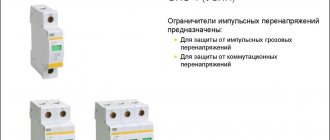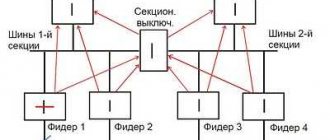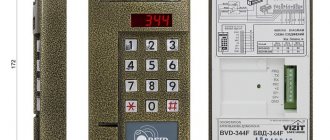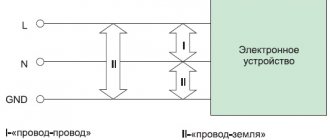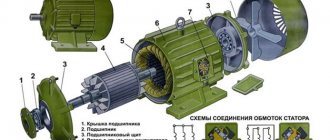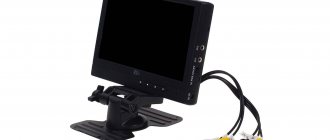SPD or voltage relay
Surge protection devices can save devices from failure. A voltage relay, or RN, protects against small surges of up to several hundred volts, but does not protect against powerful impulses, such as a thunderstorm hitting high-voltage lines or a break in the neutral wire. There is a special device for this - an SPD; it can withstand huge, several kilovolt, voltage pulses.
To protect against surges of different strengths, different devices are needed, so the choice - an SPD or a voltage relay - is not even worth it: you need to install both. In tandem, they will provide excellent protection of the home electrical network from force majeure circumstances. So the SPD is like a guardian angel for household appliances.
Is protection required if there is external lightning protection?
A private house usually has external lightning protection installed. But it cannot completely prevent impulses. Moreover, in the event of a strong discharge, the damage to electrical equipment will be significant. The purpose of the devices is to reduce the voltage surge to a value that devices powered from the network can withstand. First-class devices must divert the impulse before it enters the house to ground.
The main issues on lightning protection are addressed in GOST R IEC 62305:2010, and the application requirements are set out in GOST R 54986-2012 IEC 61643-21 and IEC 62305-2, IEC IEC 61643-22:2015, GOST R 50571.5.53-2013 IEC 60364-5-53:2002. This takes into account all classes of devices and the differences between them. And their correct installation allows you to completely prevent any losses from a pulse discharge.
Also, requirements for protective measures against surge voltages are available in STO 56947007-29.240.10.248-2017, 56977007-29.120.40.093-2011, 56947007-29.240.10.167-2014.
Operating principle
After connecting the SPD according to the appropriate circuit, it begins to pass current. As soon as the design power surge occurs, the excess power is dumped to ground. The operating principle allows the device to withstand only a certain number of operations, after which it will require complete replacement.
To visualize the status of suitability, many arresters - alternating voltage limiters - provide a color indicator:
- green color means suitability;
- red indicates the need for replacement.
If it is not possible to replace a failed device, it is recommended to dismantle it - this will reduce problems. The way SPDs work is not how other protection systems work.
Top best surge protectors class 3 and 2+3
Albatross SPD 220/1000-AS
A cheap option designed for street use. It has a durable body, protection degree is IP65, so rain, snow and dirt will not cause damage. Recommended operating temperature varies: from -40 to 40 degrees. The product is completely sealed and designed for daily use.
The average cost is 940 rubles.
Albatross SPD 220/1000-AS
Advantages:
- Cheap;
- Does not allow dust and moisture to pass through;
- Compactness;
- High period of work.
Flaws:
- Not found.
OBO Bettermann V10 COMPACT 385
An excellent device from a German manufacturer that can be installed on a DIN rail without taking up much space. Equipment class – 2+3. Inside there is a high-power varistor, there is thermal and dynamic protection in the form of a fuse. Degree of protection – IP20.
Sold at a price of 12,900 rubles.
OBO Bettermann V10 COMPACT 385
Advantages:
- High-quality execution;
- Doesn't take up much space;
- Affordable price;
- Protective voltage – 1500 V.
Flaws:
- Not detected.
RIF-E-III 320/3 (3+1)
A reliable third-class element that will protect the consumer from high voltage surges. Placed on a rail and takes up little space. Most often used for single-phase power supply networks, it is possible to install it together with a residual current device. This will increase the efficiency of the device. Made in a standard plastic case.
Sold at a price of 2,900 rubles.
RIF-E-III 320/3 (3+1)
Advantages:
- Durability;
- Efficiency;
- Trouble-free operation;
- Safety;
- Possibility of joint use with RCD.
Flaws:
- Not detected.
SPD classification
Due to the division of electrical networks by type, their protection devices were also divided into types. SPD classes existing today have number and letter designations corresponding to the connection diagram.
- First class devices, also known as class B, are installed in shields that protect entire houses. They take the first blow and reduce the voltage to an acceptable level for the next class.
- The second class is designated by the letter C. Installation of an SPD of this type is necessary for private and small houses. They soften even more the spontaneous impulse, which can already be drowned out without problems by surge protectors or the home appliances themselves.
- Third class surge arresters under the letter D bring the received impulse to the usual everyday value. Such devices are much simpler and cheaper than class B limiters, and therefore can be included in household appliances.
Similar: Difavtomat: connection diagram
Simply put, the difference between them can be boiled down to a definition: different degrees of protection, but supplemented if necessary.
SPD classes and the difference between them
Devices of this type are divided into SPD classes, and the difference between them is significant. Its application depends on these features.
SPD 1st class
In this case, the protection is activated if:
- a lightning strike that affected systems providing external protection;
- lightning struck power lines close to the protected object.
The device protects against impulses with characteristics of 10-350 μs, 25-100 kA.
Is SPD protection class 1 required for residential buildings? Definitely yes, but exclusively for apartment buildings. Equipment of this class is installed in the ASU/main switchboard of administrative buildings and industrial buildings.
SPD 2 class
Means of this type protect against impulses within the range of 8/20 μs with an amplitude of 15-20 kA. They can be used as protection against power surges in the power transmission system. They can also protect power lines from lightning. Most often they are mounted as additional lightning protection.
The installation of a charger in this case serves to neutralize pulses that have passed the first barrier from first-class equipment. Equipment of this type is mounted in distribution boards, directly connected to the network.
SPD 3 class
This equipment is designed to protect against impulses during residual voltage surges.
They protect devices of this class from pulses within 1.2/50 and 8/20 µs. They are built into protection systems as a complement to the first two types of devices. The use of third-class surge protection devices is advisable when protecting electronic and electrical equipment. Most often, the equipment is installed during the installation of medical and high-tech equipment.
Is this type of SPD protection required for residential buildings? Definitely. It will be relevant both for the private sector and for apartments.
What kind of surge protector is needed for a private house? As a rule, devices of all three types will not interfere. They only require their correct installation, focused on the use of SPDs.
How to choose an SPD
When purchasing a device, the end user must first determine what needs to be protected and in what location the building being protected is located. The choice of SPD for a private home is usually based on the protection of household devices - computers, alarms, stereo systems and other equipment.
Modern GOSTs define four levels of risk, which help the consumer choose an SPD both for the home and for the equipment located in it. The risk is determined based on the position of the house:
- The first, lowest level of risk is a city or suburb. Typically, local authorities install the necessary protective devices, so the end user does not have to worry about SPDs of the first and second classes.
- The second degree of risk is open areas. This means the absence of anything that could attract a lightning strike. Here it is worth paying attention to the second class protection apparatus.
- The third degree of risk arises when the building is close to power line supports, forests, lakes and mountains. According to GOST, such objects must be equipped with three-stage protection without fail.
- The fourth, highest, degree of risk requires agreement with engineers, who can supply additional devices to the three-stage protection. This degree of danger is assigned to buildings located fifty meters or less from lightning rods.
Four degrees of risk according to GOSTs are combined into two types:
- The first type, which combines the third and fourth degree of risk, requires the installation of high-capacity arresters in conjunction with a lightning rod.
- The second type recommends installing the arrester in a cascade type, after the arresters of the first type, or separately.
It is recommended to give preference in choosing protection devices to one of many manufacturers. And the point here is not the commercial component, but the possible difference in characteristics, which sometimes plays a decisive role.
Dangers of a thunderstorm
At school, students study the nature of this formidable phenomenon. Both a direct lightning strike and the accumulation of electricity in the environment are both dangerous. Pulse overvoltages are dangerous because:
- electrical appliances, at a minimum, fail, and at maximum, a fire starts;
- fire in buildings, buildings and structures is possible. It usually results from an insulation breakdown in wiring, equipment, equipment and a short circuit.
People often die during thunderstorms. And not from a direct lightning strike.
It is not typical for multi-storey buildings to have lightning strike the power supply network. Rather, it will induce voltage over a significant distance within the area of impact into the ground. This is less dangerous, but has a negative impact on the insulation of electrical equipment. A lightning strike near a house causes a sharp surge in voltage. Household appliances, equipment and equipment usually do not survive the impact.
The salvation in this case is the installation of protective installations. The equipment will also help in case of man-made surge voltages. The latter arise due to overloads at transformer and distribution substations. The question of whether to install protective devices or not is not relevant. The question must be, what kind of SPD is needed for a private house, or how to choose a SPD for a private house based on class or operating principle?
Lightning protection in a private home
The position of a private house, its proximity to dangerous objects and the city, influences the choice of protection scheme. The owner of a private house located in the third risk zone is recommended to purchase a lightning rod and install it more than 50 meters from the house.
The house itself is protected in this case according to a three-stage scheme. Private houses in urban areas can get by with two-stage protection. It is better to play it safe by contacting the appropriate engineering authority. They will explain how to connect the protection line in the best way.
Similar: Circuit Breaker Release
Surge protection device: how to choose and install the module correctly
Imagine a picture when the accumulated energy of static electricity between clouds moving over long distances is discharged by a lightning strike on a building or the power line feeding it.
The average shape of the current pulse is shown below. It first increases steeply for about 10 microseconds, and then, having reached its apogee, begins to gradually decrease. Moreover, the decrease to the middle of the maximum current value occurs after 350 μs and continues further until zero.
This lightning impulse creates an overvoltage in the network, which approximately follows the shape of the current, but may differ due to the operation of surge suppressors installed on overhead power lines.
The shape of such a pulse processed by spark gaps is shown a little to the right, and a conventional sine wave with a frequency of 50 hertz is below for comparison.
Power line surge suppressors operate by breaking through a calibrated air gap with an increased discharge pulse. In the normal state, its resistance prevents the flow of currents from a voltage of normal magnitude.
The limiters of high-voltage power lines are quite impressive in size.
On 0.4 kV overhead power lines their dimensions are significantly smaller. They are located on a support next to the insulators.
Overvoltage suppressors for overhead lines are capable of extinguishing very high lightning voltages only up to 6 kilovolts. Such a pulse has a modified voltage rise and fall shape with a characteristic of 8/20 μs. It goes to the input devices of your home.
Transmission line surge protection has greatly reduced and transformed it. But this is clearly not enough to ensure the safety of equipment and residents.
Household wiring 220/380 volts is produced with insulation capable of withstanding impulses of 1.5 ÷ 2.5 kV. Anything bigger breaks it. Therefore, it is necessary to use an additional surge protection device for a private home.
The range of such designs is extensive. They need to be able to select and install correctly.
SPDs for a 0.4 kV network are available for 2 possible emergency extinguishing modes:
- discharge current with a form of 10/350 μs, which did not change from the surge arrester of the overhead power line;
- overvoltage pulse with characteristic 8/20 μs.
Based on these factors, it is convenient when choosing an SPD to use the algorithm that I showed in the picture below.
However, one should imagine that there are practically no devices capable of one-time extinguishing a 6 kilovolt pulse to a value of 1.5 kV that is safe for household wiring.
This process occurs in three stages. Each of them uses its own class of SPD, although there are small exceptions to this rule.
Class 1 modules are capable of reducing an overvoltage impulse from 6 to 4 kV, which penetrates:
- after power line limiters;
- or induced by the lightning discharge current flowing down the lightning rod;
- or its impact on nearby buildings, trees, or soil.
Class 1 surge protectors are installed in the building's input panel inside a separate sealed fireproof cell. Neglecting this rule is dangerous.
During installation, the protected cables must be laid correctly. They should not intersect with the discharge of emergency currents to the ground circuit and incoming, unprotected highways.
The modules are protected from overcurrents by power fuses with fuse links.
Automatic switches are not suitable for these purposes. Their contacts cannot withstand the generated impulse overloads. They are welded, and the damage continues to develop.
The next class of SPD No. 2 reduces the overvoltage impulse from four to 2.5 kV. It is placed in the next distribution board in the hierarchy, for example, an apartment one. It complements the work of the previous module, but can also be used autonomously.
Class No. 3 surge protection devices can be made in modules installed on a DIN rail or in kits built into household appliances, extension cords, and surge protectors.
SPD of class 3 is capable of ensuring safety only after protection of class No. 2 is triggered. It is placed in series behind it because at 4 kilovolts it burns out.
Manufacturers are concerned about the complexity of choosing the correct SPD design and offer a comprehensive solution to this issue with a general module called 1+2+3.
It is placed in a separate box. However, the price of such a development is not affordable for everyone.
Three SPD connection schemes:
There are two types of TN-S circuit, characterized by high cost but also high safety; and TN-C, adopted back in the USSR, is cheap, but requires additional device protection.
The ideal circuit for connecting an SPD should be selected based not only on budget, but also on safety considerations. Any scheme is valid both in a private house and in multi-apartment housing.
Main purpose
Lightning is a fascinating and beautiful natural phenomenon that, in some way, contributed to the discovery of fire. Although it can be predicted, it is impossible to pinpoint exactly where billions of Volts will strike. Therefore, no one excludes the possibility that this point will be a country house. If this happens, there is a possibility of failure of all household appliances and a fire.
To protect your property, it is important to install external lightning protection, which is made of a receiver (placed above the roof), as well as a discharge and grounding. These elements will ensure the safety of the structure and electrical appliances.
It should be remembered that the discharge current, which penetrates a small pulse through a specific section of the electrical circuit, has a high value. It causes overvoltage in cables located nearby, which leads to melting of the insulating material and damage to household devices.
It is to prevent such situations that special products were invented that reduce to zero all the consequences caused by a lightning discharge. Lightning protection consists of complex devices that are made using SPD modules. The connection is made to the ground loop.
Such a system shows excellent results not only in private homes or industrial areas; in addition, it eliminates lightning discharges that strike:
- Into the power supply line;
- In trees or buildings that are located near the discharge site;
- Into the soil.
The situation is more understandable when lightning penetrates a power line, but why is it dangerous to strike a tree or soil!? The danger is that the resulting overvoltage that occurs after a discharge can be transmitted to the home cable in a short-term pulse. If there are no protection devices, then the situation will be deplorable, as almost all equipment will fail.
Three-phase network grounding system TN-S
It differs from a single-phase circuit in that it uses three supply conductors instead of one. The scheme is used throughout Europe; domestic consumers know it from European sockets with three sockets. The connection of an SPD in a three-phase network of this type must be done before the voltage is output to the end devices.
General characteristics of TN-S circuits
- Unlike the outdated Soviet TN-C, the European circuit operates faster and prevents energy leakage, which makes it possible not to ground the protected devices themselves.
- By separating the ground and neutral lines, their maintenance is carried out less frequently and the protection efficiency increases.
- There is no need for jumpers between the body of the protective equipment and the ground loop, which improves aesthetics while eliminating operational inconvenience.
- The effectiveness of protecting sensitive equipment is increased by eliminating high-frequency interference.
Choosing an SPD for a private home
Modern private homes have a large number of expensive electrical appliances. At the same time, all devices are at risk of being dangerously affected by surge voltages. These effects arise both from a lightning strike and from internal switching effects in the electrical network. In all cases, a sharp multiple increase in voltage occurs on electrical equipment, which disables electrical appliances.
One of the effective measures to protect against the dangerous effects of sharply increasing voltage is the installation of Surge Protection Devices
and Interference (SPD).
SPD protective elements are installed between supply wires and grounding, as well as between telecommunication lines and grounding. During an overvoltage, the protective elements sharply reduce their resistance and divert the overvoltage pulses to the ground electrode, due to which the influencing surge overvoltage is significantly reduced.
EZETEK Company
presents a wide range of protective devices against dangerous surge voltages. All these devices are classified:
- Depending on the protective elements used;
- Depending on the test class and installation location.
SPD selection procedure:
- Determination of hazardous influences and required classes of SPD;
- Determination of SPD design depending on the grounding system;
- Determination of SPD protection reliability levels.
For electrical equipment, lightning strikes into the lightning protection of a private home, as well as into the overhead power line that supplies power to the facility, are especially dangerous. In these cases, the most powerful overvoltages occur in the power supply system. Overvoltages are characterized by a duration equal to the time of lightning current flow. If there is an overhead power line or lightning protection at the facility, SPDs are installed in the main input panel to protect electrical equipment in class I or I+II power supply systems. Examples of such devices are SPDs:
EZ 2B 12.5/275
– SPD for single-phase input switchboard;
ET B 75/275 (3+0)
– SPD for three-phase input switchboard.
If there is a cable insert from the nearest overhead power line pole to the private house itself, a Class I+II SPD is also installed.
If a private house does not have a lightning protection system and when the facility is powered from a cable power line all the way from the substation, there is a risk of damage to electrical equipment only from induced voltage during a lightning strike. A class II surge protector installed in the main switchboard of the house protects against this kind of impact. Examples of protection devices against induced overvoltages are SPDs:
EZ C 80/275 (2+0)
– SPD for single-phase input switchboard;
EZ C 160/275 (4+0)
– SPD for three-phase input switchboard.
The design of the SPD depends on the grounding system of the private house. SPDs can be used:
- Based on varistors;
- Based on varistors and arresters.
SPDs are considered next
for single-phase power supply systems of a private house with a rated voltage of 220 V and for three-phase systems of 380 V line voltage (220 V phase voltage).
The most common three options for implementing grounding systems are:
1. The grounding of a private house is combined with the neutral working conductor in the main switchboard (TN-CS grounding system).
In this case, SPDs are installed between the phase conductors (L1-L3) and the combined zero working and zero protective conductor (PEN) based on varistors.
Examples of devices with a maximum continuous operating voltage of 275 V are given below. SPD connection diagrams are shown in Fig. 1.
Figure 1. Installation of SPD in the TN-CS grounding system with separation of the neutral conductor in the water shield - a) single-phase circuit; b) three-phase circuit.
- SPD I+II class for single-phase power supply to a private house:
Art. 506264. SPD EZ 2B 12.5/275
- SPD I+II class for three-phase power supply of a private house:
Art. 504389. SPD ET B 75/275 (3+0);
- SPD II class for single-phase power supply of a private house:
Art. 500471. SPD EZ C 40/275;
- SPD II class for three-phase power supply of a private house:
Art. 500640. SPD EZ C 120/275 (3+0)
.
2. The grounding of a private house is carried out separately with the neutral working conductor (TT grounding system).
When operating such a grounding system for a private home, spreading currents through the ground electrode are reduced in the event of a break (burnout) of the working neutral conductor at the supply substation. But on the other hand, the requirements for the reliability of the grounding system are increasing.
When grounding and working zero (N) are performed separately, SPDs are installed between the phase conductors (L1-L3) and the neutral working conductor (N) based on varistors, and a surge arrester is connected between the zero working (N) and neutral protective conductor (PE).
Examples of devices based on varistors and arresters for a maximum continuous operating voltage of 275 V are given below. SPD connection diagrams are shown in Fig. 2.
Figure 2. Installation of SPD in the TT grounding system with separate neutral conductor and grounding – a) single-phase circuit; b) three-phase circuit.
- SPD I+II class for single-phase power supply to a private house:
Art. 504580. SPD ET B 25/275 (1+1).
- SPD I+II class for three-phase power supply of a private house:
Art. 504570. SPD ET B 50/275 (3+1).
- SPD II class for single-phase power supply of a private house:
Art. 500473. SPD EZ C 80/275 (1+1)
.
- SPD II class for three-phase power supply of a private house:
Art. 500472. SPD EZ C 160/275 (3+1).
3. The combination of the grounding system and the neutral working conductor occurs in the metering panel in front of the input switchboard (TN-CS grounding system with separation of the neutral conductor in the metering panel).
Figure 3. Installation of SPD in the TN-CS grounding system with separation of the neutral conductor in the metering panel - a) single-phase circuit; b) three-phase circuit.
In such a system, SPDs are recommended to be installed in the input switchboard of a private house for the most effective protection of electrical equipment inside the facility.
When combining grounding and the working zero (N) on the pole, SPDs are installed between the phase conductors (L1-L3) and the neutral protective conductor (PE) based on varistors, and between the zero working (N) and the neutral protective conductor (PE) an SPD based on varistor.
Examples of devices based on varistors for a maximum continuous operating voltage of 275 V are given below.
- SPD I+II class for single-phase power supply to a private house:
Art. 506033. SPD EZ 2B 25/275 (2+0);
- SPD I+II class for three-phase power supply of a private house:
Art. 504674. SPD ET B 100/275 (4+0).
- SPD II class for single-phase power supply of a private house:
Art. 500083. SPD EZ C 80/275 (2+0);
- SPD II class for three-phase power supply of a private house:
Art. 500723. SPD EZ C 160/275 (4+0).
For additional equipment protection, class III surge protectors are installed in close proximity to the protected equipment. The SPD protects against induced overvoltages, as well as from residual impulses after the operation of SPDs of class I and II. Effectively protects class III surge protectors with a cable length of less than 10 m to the protected equipment.
Examples of devices based on varistors for a maximum continuous operating voltage of 275 V are given below.
Art. 508184. SPD EZ DM 10/275 (2+0)
— single-phase SPD of class III for installation in a distribution board;
Art. 130004. SPD ERM ZE MINI 275
– single-phase SPD of class III for installation in the socket housing.
Conclusions:
- The SPD
is installed in the input panel of a private house; - If there is an overhead power line, an SPD of class I+II is installed;
- If lightning protection is available, an SPD of class I+II is installed;
- In the absence of lightning protection and an overhead power line, it is sufficient to install a Class II SPD;
- For a private house with a supply voltage of 220/380 V, SPDs with a maximum continuous operating voltage of 275 V are installed;
- To install an SPD, a necessary condition is the presence of grounding of the object;
- The number and type of SPD protective elements depend on the grounding system of a private house;
- To protect against residual impulse influences, a Class III surge protection device is installed directly next to the equipment.
Three-phase network grounding system TN-C
The Soviet grounding system, the peculiarity of which is the combination of the neutral and grounding circuits, for which purpose in modern houses with this circuit a fuse is installed in front of the SPD. And all because when calculating the third phase in outdated houses, a lot of modern ones were not taken into account.
At the moment, although this scheme exists in operation, it is being replaced, whenever possible, by safer European schemes. If the use of the European scheme is impossible, for example, in an apartment building, then the connection to your electrical network must be equipped with additional protection.
Rating of the best class 1 models
DEHNsecure DSE M 2P 60
A two-pole device that is designed to provide protection against surge voltages in the home or at work. The product connection diagram is 1+1. The device has a high throughput capacity of up to 25 kA. The maximum voltage is 60 V. In addition, energy coordination with class 2 is provided, which allows uninterrupted operation in various situations. There is a remote alarm that will simplify the operation of the product.
The case is made of high-quality material, which is highly resistant to various environments. The device operates at temperatures from -40 to 80 degrees. The degree of protection is IP20, which is suitable for installation in most production factories. Also, a distinctive feature of this element is its light weight and dimensions, which allow it to be installed with maximum comfort. The SPD has passed all tests and has the appropriate certificates that confirm this.
A positive point is high resistance to various vibrations that may occur during operation. In addition, there is a quick lock and release system that is unique to this module. For greater convenience, the manufacturer has provided the installation of a light indication, which allows you to monitor the operating status of the device.
The average cost is 45,000 rubles.
DEHNsecure DSE M 2P 60
Advantages:
- The product is made on the basis of spark gaps;
- Capacity reaches 25 kA;
- There is the possibility of working together with a second class SPD;
- Easy replacement of modules thanks to a unique system;
- Light indication;
- Vibration resistance.
Flaws:
- Not detected.
Schneider Electric PRD1 Master C1 surge arrester-3
A good product from a top brand that will provide protection for your home and production. There are three poles. Works well with TN-C grounding system. The rated operating voltage is 230 V. The equipment can cope with lightning discharges without any problems. Composition of signal contacts 1 SD. Sold in anthracite color, body made of PBT. Thanks to its unique design, the device is easy to remove and fix, and the chance that it will accidentally come off is minimal.
Sold at a price of 70,000 rubles.
Schneider Electric PRD1 Master C1 surge arrester-3
Advantages:
- High-quality protection in any building;
- High efficiency;
- Safety;
- Reliable and durable connection.
Flaws:
- High price.
OBO Bettermann MCD 50-B 3+1
Combined model with 4 poles, designed for use in TN-S or TT networks. The device is completely ready for use; a person only needs to buy it and install it in the distribution panel. The body is made of durable material that will not ignite due to high heat generation. This product is produced by a well-known German company that has been selling only high-quality products for decades. Current carrying capacity – 125 kA per pole.
The average price is 87,900 rubles.
OBO Bettermann MCD 50-B 3+1
Advantages:
- High efficiency;
- High-quality execution;
- Suitable for installation in many buildings;
- Durability of work;
- Complies with international electrical safety standards.
Flaws:
- Price.
DKS NX1012
Inexpensive product intended for placement in everyday life or small production lines. Made from high-quality materials that can guarantee long-term operation and trouble-free operation. The main difference between this item is that the product is made to order, which means you don’t have to worry about its quality. The rated pulse current discharge is 50 kA, which is a positive point and allows the product to be classified in the first category. The SPD is small in size and will take up minimal space in the electrical panel.
The average price is 8,700 rubles.
DKS NX1012
Advantages:
- Low price;
- Efficiency;
- Suitable for home installation;
- High-quality assembly;
- Made to order.
Flaws:
- Up to 50 kA.
ABB OVR T1 3N 25-255 TS (ABB 2CTB815101R0600)
A high-quality model, which is produced only to order. Suitable for placement in an enterprise or home. The design size of the product is 8 modules, so installation will require more free space in the distribution panel. System configuration – TT. Residual current extinguishing ability with 50 kA. The outer shell is made of durable material that will not be damaged mechanically and will not deteriorate due to high heat generation. The issue is carried out by a proven company that has positively proven itself in the market over a long period.
The average cost is 65,900 rubles.
Lightning protection arrester for power supply systems ABB 2CTB815101R0600
Advantages:
- Reliability;
- Efficiency;
- High-quality assembly;
- Long service life;
- Durable housing;
- Good element base;
- Optimal price.
Flaws:
- Not found.
Connection errors
- Poor grounding: before installing the SPD, you need to make sure that the grounding is reliable - it must withstand the pulses thrown onto it and be in good condition, otherwise it will burn out in the first thunderstorm, dragging the entire electrical panel with it to the next world.
- Error in the connection diagram: the device must be installed with knowledge of the grounding diagram used in the panel. If there is no such knowledge, it is better to entrust the installation to a specialist who services house electrical lines, or who is as closely familiar with them as possible.
- Wrong class, wrong place: there are several classes of SPDs, and each of them is intended for certain types of switchboards. Selecting the wrong device can cost your home appliances their lives.
Similar: Differential automatic
Despite the state of modern energy networks, with their interruptions, outdated wiring, and other joys of a third world country, we continue to use technology. And no matter what happens, you can rely, among other things, on the surrounding protective mechanisms.
Operating principles of SPDs and the correct choice of device for a private home
The equipment looks like modules. They are mounted on a DIN rail or built into plugs/sockets. According to the principle of operation of the devices, there is also a division:
- valve and spark gaps;
- surge suppressors with varistors.
Varistors have an infinite resistance value. Pulse current cannot flow through them. If the voltage or pulse increases, the resistance of the varistor decreases.
Dischargers have a more complex design. They consist of a tube with inert gases and electrodes. When the voltage rises to a certain level, it breaks through the gas gap, after which the device fires.
If the current level is exceeded, the device will be destroyed, since it is designed for certain maximum discharge parameters. Which SPD is needed for a private home can only be installed if all the required parameters are identified. Our specialists can help you do this and select the necessary equipment. They will advise you on the classes of SPDs and the differences between them, and determine whether SPD protection is required in each specific case. The integration scheme largely depends on the type of grounding system.
Surge protection: private house with single-phase power supply
Installation of electrical wiring in a private house, especially one made of wood and flammable materials, requires careful adherence to electrical safety rules.
It is necessary to take into account that the building can be powered using different grounding schemes:
- typical old TN-C;
- or modern, safer TN-S or its modifications.
Let's look at both cases.
SPD connection diagram: 2 options according to the TN-S grounding system
The picture below shows a detailed circuit with protection of combined class 1+2, which is used for installation after the input circuit breaker.
The surge suppressor varistor is built into the module housing and protects the electrical circuit from direct or remote atmospheric lightning discharges.
The signal flag, traditional for all SPDs, has two colors:
- the green position indicates that the device is working properly and is ready for operation;
- red - about the need for replacement in case of operation or burnout.
Such a module can be used in all grounding systems, not just TN-S. It has 3 connection terminals:
- top left L - phase wire;
- top right PE - protective grounding conductor;
- bottom N - neutral wire.
The SPD protects the electric meter and all circuits after it.
The next diagram shows an option for using protection with an RCD. After it, an additional working zero bus N1 is created, from which all consumers in the apartment are powered.
The scheme seems clear, there should be no questions.
For additional TN-CS and TT grounding systems, I propose two more schemes for study and analysis. They also have an SPD mounted in the input device.
I do not show the meter connection circuits, voltage control relays RKN and RCD, as well as consumers in detail. But the principle is clear: a PE protective bus is used.
But the old grounding system does not have it, which reduces reliability and safety. But it still provides protection, which is why it is considered.
SPD connection diagram using TN-C grounding system
The absence of a PE bus dictates the need to connect an SPD only between the potentials of the phase wire and PEN. There are simply no other options.
The method of installing protection for single-phase wiring is shown on the left, and three-phase wiring is shown on the right.
The overvoltage pulse is removed by the principle of creating an artificial short circuit in the supply circuit.

